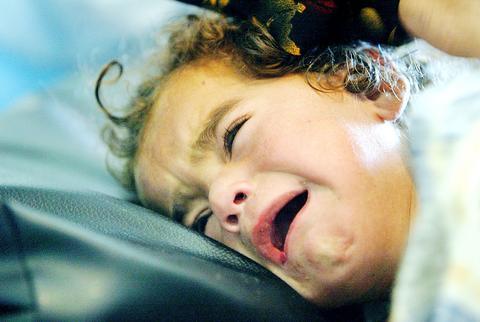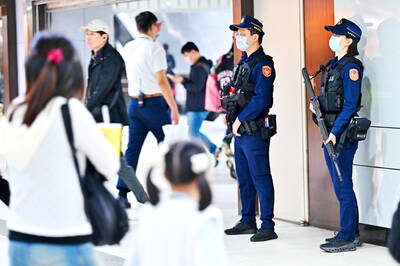The bride arrives in a white pickup truck and is quickly ushered into a house by a group of women. Outside, men recline on brightly colored silk pillows, relaxing on the carpeted floor of a large goat-hair tent as boys dance to tribal songs.
The videotape obtained Sunday by Associated Press Television News (APTN) captures a wedding party that survivors say was later attacked by US planes early Wednesday, killing up to 45 people. The dead included the cameraman, Yasser Shawkat Abdullah, hired to record the festivities, which ended Tuesday night before the planes struck.

PHOTO: AP
The US military says it is investigating the attack, which took place in the village of Mogr el-Deeb about 8km from the Syrian border, but that all evidence so far indicates the target was a safe house for foreign fighters.
"There was no evidence of a wedding: no decorations, no musical instruments found, no large quantities of food or leftover servings one would expect from a wedding celebration," Brigadier-General Mark Kimmitt, the chief US military spokesman in Iraq, said on Saturday. "There may have been some kind of celebration. Bad people have celebrations, too."
But video that APTN shot a day after the attack shows fragments of musical instruments, pots and pans, and brightly colored beddings used for celebrations, scattered around the bombed out tent.
The wedding videotape shows a dozen white pickup trucks speeding through the desert escorting the bridal car -- decorated with colorful ribbons. The bride wears a Western-style white bridal dress and veil. The camera captures her stepping out of the car but does not show a close-up.
A reporter and photographer, who interviewed more than a dozen survivors a day after the bombing, were able to identify many of them on the wedding party video -- which runs for several hours.
APTN also traveled to Mogr el-Deeb, 400km west of Ramadi, the day after the attack to film what the survivors said was the wedding site. A devastated building and remnants of the tent, pots and pans could be seen, along with bits of what appeared to be the remnants of ordnance, one of which bore the marking "ATU-35," similar to those on US bombs.
A water tanker truck can be seen in both the video shot by APTN and the wedding tape obtained from a cousin of the groom.
The singing and dancing seems to go on forever at the all-male tent set up in the garden of the host, Rikad Nayef, for the wedding of his son, Azhad, and the bride, Rutbah Sabah. The men later move to the porch when darkness falls, apparently taking advantage of the cool night weather. Children, mainly boys, sit on their fathers' laps; men smoke an Arab water pipe, finger worry beads and chat with one another. It looks like a typical, gender-segregated tribal desert wedding.
As expected, women are out of sight -- but according to survivors, they danced to the music of Hussein al-Ali, a popular Baghdad wedding singer hired for the festivities. Al-Ali was buried in Baghdad on Thursday.
Prominently displayed on the video-tape was a stocky man with close-cropped hair playing an electric organ. Another tape, filmed a day later in Ramadi, showed the musician lying dead in a burial shroud -- his face clearly visible and wearing the same tan shirt as he wore when he performed.
As the musicians played, young men milled about, most dressed in traditional white robes. Young men swayed in tribal dances to the monotonous tones of traditional Arab music. Two children -- a boy and a girl -- held hands, dancing and smiling. Women are rarely filmed at such occasions, and they appear only in distant glimpses.
Kimmitt said US troops who swept through the area found rifles, machine guns, foreign passports, bedding, syringes and other items that suggested the site was used by foreigners infiltrating from Syria.
The video showed no weapons, though they are common among rural Iraqis.
Kimmitt has denied finding evidence that any children died in the raid although a "handful of women" -- perhaps four to six -- were "caught up in the engagement."
"They may have died from some of the fire that came from the aircraft," he said on Friday.
However, an AP reporter obtained names of at least 10 children who relatives said had died. Bodies of five of them were filmed when survivors took them to Ramadi for burial on Wednesday. Iraqi officials said at least 13 children were killed.
Four days after the attack, the memories of the survivors remain painful -- as are their injuries.
"At about 3am, we were sleeping and the planes started firing," said one of the mourners, who gave his name only as Bassem. "They fired more than 40 missiles. As soon as they started attacking, firing the first missile, I went away. I was running. ... There are no fighters. These are lies. There's no resistance. Even the bride and the groom died."
Haleema Shihab, 32, one of the three wives of Rikad Nayef, said that as the first bombs fell, she grabbed her seven-month-old son, Yousef, and clutching the hands of her five-year-old son, Hamza, started running. Her 15-year-old son Ali sprinted alongside her. They managed to run for several meters when she fell -- her leg fractured.
"Hamza was yelling, `Mommy,'" Shihab recalled. "Ali said he was hurt and that he was bleeding. That's the last time I heard him." Then another shell fell and injured Shihab's left arm.
"Hamza fell from my hand and was gone. Only Yousef stayed in my arms. Ali had been hit and was killed. I couldn't go back," she said from her hospital bed in Ramadi.
She and her stepdaughter, Iqbal then hid in a bomb crater. "We were bleeding from 3am until sunrise," Shihab said.
Shihab's stepdaughter, 14-year-old Moza, lies on another bed of the hospital room. She was hurt in the leg and cries. Her relatives haven't told her yet that her mother, Sumaya, is dead.
Her sister, Iqbal, lay in pain on the bed next to her. Her other sister, Subha, was on the upper floor of the hospital.

TRAGEDY STRIKES TAIPEI: The suspect died after falling off a building after he threw smoke grenades into Taipei Main Station and went on a killing spree in Zhongshan A 27-year-old suspect allegedly threw smoke grenades in Taipei Main Station and then proceeded to Zhongshan MRT Station in a random killing spree that resulted in the death of the suspect and two other civilians, and seven injured, including one in critical condition, as of press time last night. The suspect, identified as a man surnamed Chang Wen (張文), allegedly began the attack at Taipei Main Station, the Taipei Fire Department said, adding that it received a report at 5:24pm that smoke grenades had been thrown in the station. One man in his 50s was rushed to hospital after a cardiac arrest

SAFETY FIRST: Double the number of police were deployed at the Taipei Marathon, while other cities released plans to bolster public event safety Authorities across Taiwan have stepped up security measures ahead of Christmas and New Year events, following a knife and smoke bomb attack in Taipei on Friday that left four people dead and 11 injured. In a bid to prevent potential copycat incidents, police deployments have been expanded for large gatherings, transport hubs, and other crowded public spaces, according to official statements from police and city authorities. Taipei Mayor Chiang Wan-an (蔣萬安) said the city has “comprehensively raised security readiness” in crowded areas, increased police deployments with armed officers, and intensified patrols during weekends and nighttime hours. For large-scale events, security checkpoints and explosives

PUBLIC SAFETY: The premier said that security would be tightened in transport hubs, while President Lai commended the public for their bravery The government is to deploy more police, including rapid response units, in crowded public areas to ensure a swift response to any threats, President William Lai (賴清德) said yesterday after a knife attack killed three people and injured 11 in Taipei the previous day. Lai made the remarks following a briefing by the National Police Agency on the progress of the investigation, saying that the attack underscored the importance of cooperation in public security between the central and local governments. The attack unfolded in the early evening on Friday around Taipei Main Station’s M7 exit and later near the Taipei MRT’s Zhongshan

ON ALERT: Taiwan’s partners would issue warnings if China attempted to use Interpol to target Taiwanese, and the global body has mechanisms to prevent it, an official said China has stationed two to four people specializing in Taiwan affairs at its embassies in several democratic countries to monitor and harass Taiwanese, actions that the host nations would not tolerate, National Security Bureau (NSB) Director-General Tsai Ming-yen (蔡明彥) said yesterday. Tsai made the comments at a meeting of the legislature’s Foreign Affairs and National Defense Committee, which asked him and Minister of National Defense Wellington Koo (顧立雄) to report on potential conflicts in the Taiwan Strait and military preparedness. Democratic Progressive Party (DPP) Legislator Michelle Lin (林楚茵) expressed concern that Beijing has posted personnel from China’s Taiwan Affairs Office to its